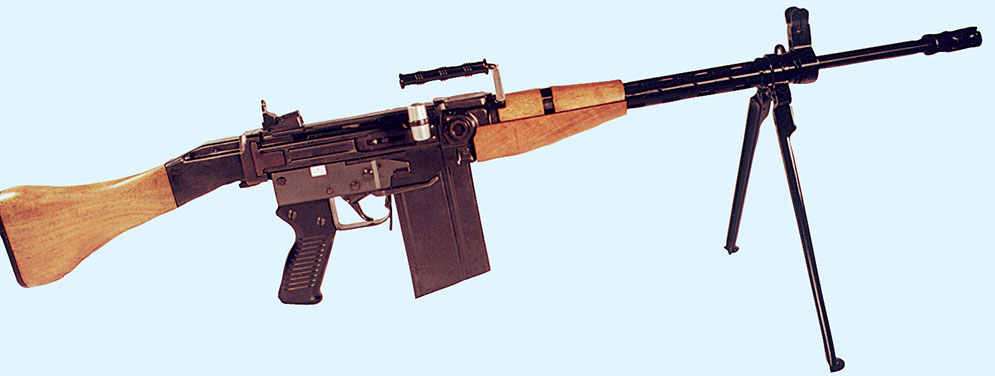By William R. Bishop
This article provides an overview of what is arguably the highest quality military-style rifle to ever be imported into America – the SIG AMT. By understanding the background, technical details, operating characteristics and accessories of the SIG AMT you will gain a perspective into why it is considered one of the finest rifles of its type in existence. Have doubts about this grandiose statement? Then read on!
Background
During the period 1954-1957 the Swiss firm of Schweizerische Industrie Gesellschaft (SIG) designed an assault rifle which ultimately became the Sturmgewehr (StGw) 57. The StGw57 was in the 7.5mm Swiss caliber and borrowed ideas from the earlier Spanish CETME Model L and Mauser StG45 rifles. Chief among these ideas was using a receiver of stamped steel along with a delayed-blowback operating system comprised of a bolt assembly utilizing twin locking rollers. These locking rollers are most commonly seen today in H&K rifles.
The Swiss military used the StGw57 from 1957-1986 at which time it was phased out in favor of the newer StGw90 in 5.6mm GP90 caliber. However, throughout the distinguished 30-year service life of the StGw57 several updates to the basic design took place. These were done to increase its suitability for export purposes onto the global arms market. The updated StGw57, when exported out of Switzerland, then became known as the StGw510.
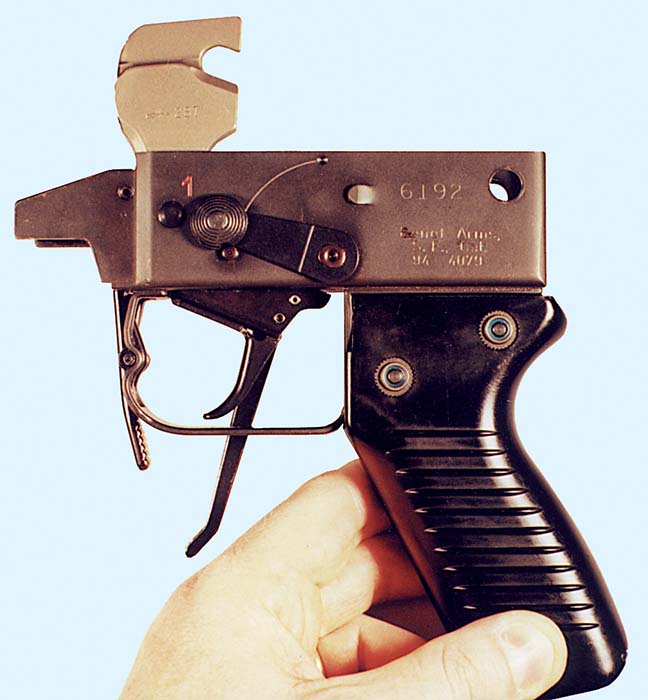
Options available within the 510-series included differing calibers, weight reductions, ergonomic refinements and simplified sighting equipment. There were five versions of the 510. These included:
510-1 Same as the StGw57 but renamed for export purposes
510-2 Lightweight version of the 510-1
510-3 Same as the 510-1 but in 7.62x39mm caliber
510-4 Same as the 510-1 but in 7.62mm NATO caliber
510-5 Same as the 510-1; Mexican Army prototype in 30-06 caliber
Throughout the period 1969-1989, SIG exported two versions of the 510 into the US. One was the 510-1 which was renamed for sales purposes as the PE57 and remained chambered in 7.5mm Swiss. The other was the 510-4. The remainder of this article will touch on the 510-4 and then detail its refined brother – the superb SIG American Match Target (AMT).
In 1969 several SIG 510-4’s, perhaps less than a dozen, were imported into the US. These were legally parallel to the FN “G” series rifle in that they were built around full automatic receivers with semi automatic internals. However, BATF approved these rifles as semi-automatics and therefore not falling under the restrictions of the NFA.
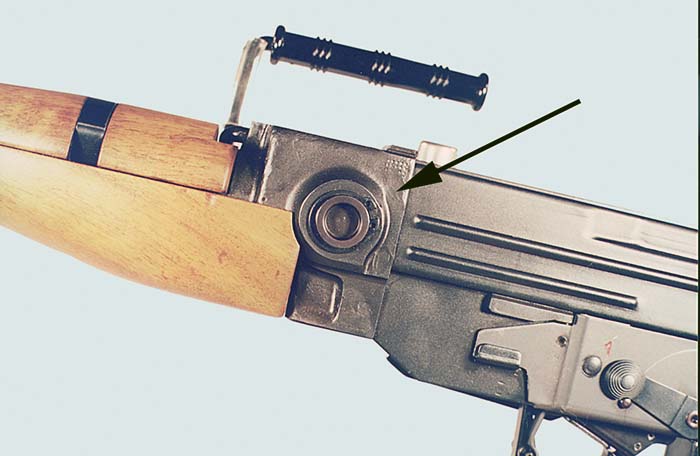
Later in 1969 SIG responded to emerging gun regulations in other countries (notably England and Italy) by slightly modifying the 510-4 to make it more “sporting”. This included deleting the bayonet mount and rifle grenade rings on the barrel. When imported into the United States this now became the SIG AMT. Benet Arms, SARCO, Osborne Brothers (import marking of “OSS”!), Mandall, SIGARMS and Golden State Arms all were AMT importers. It is known that 1,440 AMT’s were imported during the period 1969-1978. From 1979-1989 more AMT’s were imported although they were reportedly made up of parts which had been manufactured earlier. Total import of the AMT is estimated at 3,000 rifles for the years 1969-89. Even SIG does not know the exact number.
With a high retail price ($348 in the early 1970’s and $1700 in 1978) it was very expensive. Colt AR15’s and H&K 91’s were selling for well over a thousand dollars less during this same period. For these reasons – small supply and very high cost – the AMT is now one of the rarest military-style rifles in the United States. Market trends indicate it is now one of the most desired.
Technical Details
The AMT is superbly manufactured and finished in every respect. The traditional quality of Swiss workmanship is evident throughout all parts and functions of the rifle. After all, being directly related to the primary small arm of the Swiss military, it would have to be! Specifics on the major components of the SIG AMT follow.
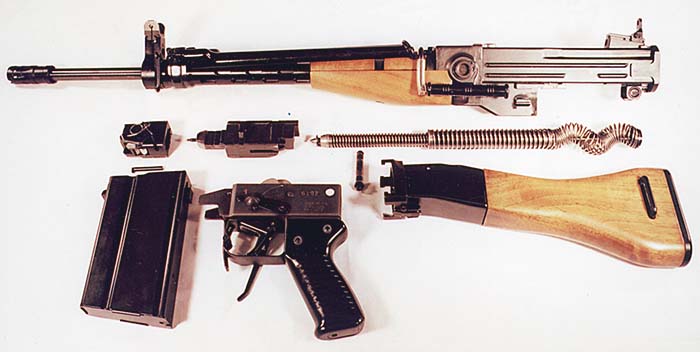
* Layout – The AMT is not a big rifle, although it visually appears to be larger than it really is. Total length is 40” with an unloaded weight of 10 pounds. The charging handle is on the right side of the receiver and is extremely easy to grasp. The large ejection port is also on the right side and there is no ejector door as on the M16. The staggered-row box magazine comes in 5, 10 and 20-round versions although the 24-round 7.5mm Swiss PE57 magazine will fit and function correctly if it has the older metal (not plastic) follower. The hollow black plastic pistol grip is quite comfortable to use and has a removable endcap to allow storing the cleaning kit.
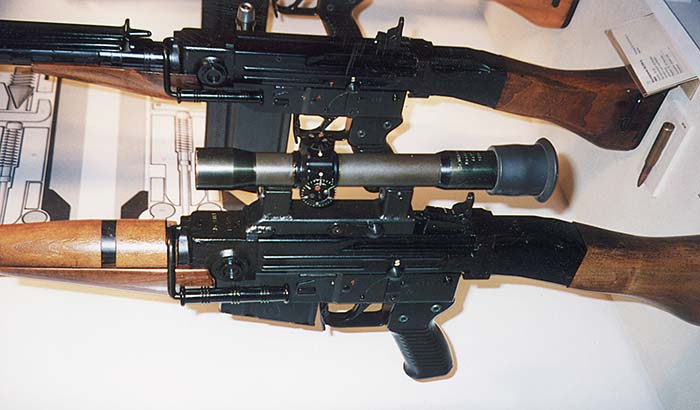
From a side view the AMT appears to be a square and perhaps bulky rifle which could be uncomfortable to use. This is definitely not the case as it very readily falls into your shoulder when firing. The relationship between buttstock, forward hand rest and trigger assembly are excellent. Overall fit and finish are the best I have ever see in any production rifle, anywhere. Finally, the major components of the AMT are all numbered to each other in traditional European fashion.
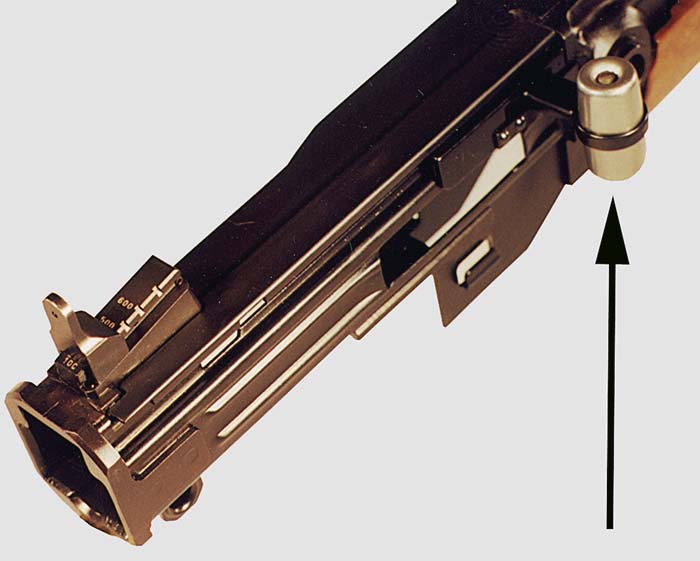
* Receiver – The receiver is essentially composed of three pieces: two end caps which are blued, and the parkerized central receiver section. The central section is stamped steel with several ribs to give rigidity and also perform a self-cleaning function. The front end cap is a cast and precision machined component which is spot welded to the central section. One unique feature of this cap is that the bolt locking roller recesses are contained in separate parts and held in place by circlips. When the recesses become worn simply pop off the circlips, install new locking recess parts, and replace the circlips. Your AMT is now ready for thousands of new rounds to be fired. The rear end cap is also spot welded to the central section and lends structural support while serving as a mount for the buttstock. Typical for the period, a carrying handle is mounted into the receiver and is placed where the AMT naturally balances.
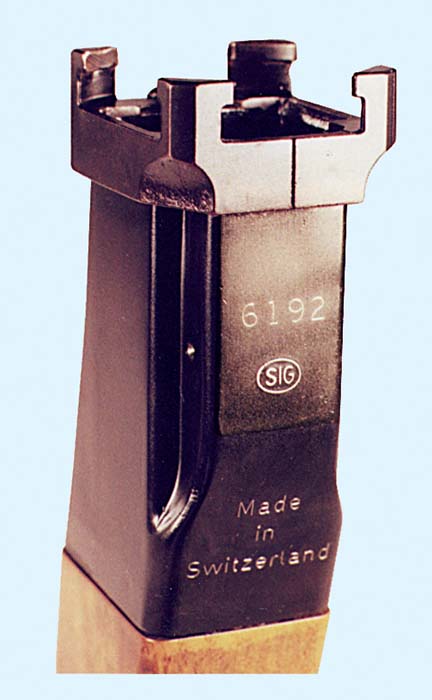
The lower receiver is also of stamped and folded steel which has been parkerized a medium gray color. It operates in the same fashion as H&K rifles since it contains the trigger/safety mechanism and pistol grip. The lower receiver is retained in the rifle by clipping the front section into two flanges with the rear locked in by a single push pin. One unique feature of the SIG AMT is it comes standard with a winter trigger. Under normal operating conditions it is folded up against the right side of the lower receiver and out of the way. To use, simply snap it down and fire with your gloved hand. Believe it or not this winter trigger is so well designed it gives an excellent “feel” of the sear disengagement and fire control. Finally, a small square metal plate is visible on the right side of the lower receiver. The external side is painted white to signify the AMT is semi-automatic. If it was reversed to its normal gray parkerized color this would visually indicate the rifle was full automatic.

* Barrel – The blued steel barrel is 19.9” long and has four-groove rifling with a 1/12” twist rate. This is an optimum geometry for 7.62mm NATO slugs in the 150-165 grain weight range. Accuracy with milspec ammunition is excellent as my AMT routinely delivers 2 MOA with iron sights and my poor eyes. The barrel is threaded and torqued into the upper receiver and is covered for 1/2 of its length by a perforated aluminum barrel casing. This casing not only assists in preventing unwanted banging of the barrel during field use but also acts as a heat sink and protection against hand burning. It is easily removable and contains the front sight assembly, hand rest and folding bipod. The barrel is also threaded for a flash suppressor which closely resembles the M16 birdcage version.
* Operating System – The AMT fires from a closed bolt. In fact, the full automatic StGw57 and 510-series all fire from the closed bolt. Pulling back on the very large charging handle (it is shaped like a miniature beer keg!) and letting it fly forward to load a round into the chamber is a very satisfying experience as all bearing surfaces are finely machined. It feels like glass sliding on glass. The charging handle has a detent which locks it forward and therefore keeps it from cycling as the bolt reciprocates. Also, the chamber is fluted to aid in initial extraction of a spent cartridge. While these flutes are not as prominent as on the H&K, there are more of them.
The AMT’s delayed blowback system uses twin locking rollers. The bolt assembly is quite similar to the H&K system in that a smaller bolt head contains the locking rollers and extractor. The larger bolt body contains the firing pin and a protruding director shaft (acts just like the H&K locking piece) which causes the locking rollers to cam into their recesses at the moment of firing. After the bullet exits the bore and pressures drop to a safe level the bolt body moves rearward and pulls back the director shaft. This allows the locking rollers to release out of their recesses and the entire bolt assembly to continue recoiling back, cock the hammer, and compress the recoil rod/spring combination. Upon reaching the limit of travel the rod/spring drives the bolt assembly forward to strip and chamber a fresh cartridge. As the bolt assembly comes back into battery the locking rollers are then cammed back into their locking recesses by the director shaft and you are ready to fire another round.
* Sights – The front sight is a post which is protected by ears. Elevation adjustment is carried out by screwing the post the appropriate direction as on the AR15. However, unlike the AR15, traversing adjustment is performed by drifting the front sight base left or right. The rear sight is of the aperture type and is spring loaded to slide up or down a ramp which is ballistically matched to the 7.62mm NATO round. This ramp is graduated with detents from 100-600 meters. Sight radius is a generous 21”.
* Furniture – All AMT’s have wood furniture composed of a buttstock and two-piece forward hand rest. The wood is French walnut which is smoothly finished under a flat polyurethane coating. While both appear to be too small, this is definitely not the case. The buttstock has a hollow scooped from its midsection to allow an excellent cheekweld and proper alignment of eye-to-sight. The forward hand rest falls readily in place and is shaped to permit a good grip at a comfortable arm/body angle. Because of its straight-line design the force of recoil is directed against the shoulder muscle and the AMT does not unduly rise even in rapid fire. It is the softest recoiling 7.62mm I have ever fired. In comparison the H&K91 and FN FAL are like elephant guns.
Operating Characteristics
Firing the AMT is a pure joy. The balance and excellent ergonomics are hard to appreciate until you shoot several hundred rounds through it – at one session.
To begin, load up the magazine and insert it into the rifle. This is done in the same manner as a FAL or H&K. Place the forward part of the magazine into the mag well and rock it backwards until it latches in place. While keeping the AMT pointed downrange, grab the very large charging handle and pull it smartly to the rear. Letting it go will immediately place a round into the fluted chamber. At this point take it off Safe and start firing. You can always tell if the AMT is loaded as a cartridge indicator is built into the upper receiver. It will pop up a fraction of an inch if a round is chambered. In the darkness you can reach forward and feel it protruding. There is also a secondary cartridge indicator which is part of the firing pin lever and viewable/touchable through the ejection port.
As there is no hold open on the AMT the bolt will not lock to the rear after the last shot. It will close on an empty magazine just like the H&K. A hint which can prevent some minor marring is to not let the AMT “run dry” on a magazine. They are hard to find and expensive ($130 each) to purchase. As you come up on the last round it is better to remove the magazine instead of having the bolt slam into the magazine follower. Make sure you take care to manually eject the round which is still in the chamber!
Offhand shooting is perhaps my favorite position with the SIG as it really brings out the rifle’s inherent solid design. However, the factory manual states the preferred position is with the built-in bipod as it yields the greatest accuracy. While not disagreeing with this statement, it does sort of take the fun out of standing up and enjoying an extremely well built firearm with minimal recoil.
Cleaning the AMT is quite simple. First, make it safe by taking out the magazine and charging it. Place the selector lever on “S” and push out the single pin which retains the lower receiver. Swing down and remove the entire lower receiver. Depress the buttstock latch, rotate the buttstock 90 degrees counterclockwise and remove it. The recoil spring and rod will come out with the buttstock. Grasp the charging handle and slide it to the rear. The bolt assembly and charging handle can now be withdrawn from the receiver. Finally, split the bolt assembly by removing the transverse key. That is all there is for general disassembly. Detail stripping is not necessary except for once or twice a year.
Standard cleaning procedures should be used but make sure no aggressive chemicals such as carb cleaner, Tetra teflon solution, Gun Scrubber, etc. come into contact with the wood furniture. The fine finish on the wood may not be able to take these aggressive compounds. Also keep in mind the fluted chamber harbors additional crud and should be addressed a little more thoroughly. A US GI 7.62mm chamber brush will work quite fine. As the upper receiver is now wide open you can properly clean the bore from the breech side.
Accessories
The AMT has available several accessories which add to the enjoyment of owning this fine weapon. In addition to the 5, 10 and 20-round magazines there is also a cleaning kit, cartridge indicator hold open tool, locked breech gauge (similar to headspace) and sight adjusting tool. Since the AMT is still being sold in Switzerland the availability of most spare parts is assured. One location to get these parts is through SIG Parts Service of Auburn, WA, or you can file the necessary Form 6 with BATF and import them yourself.
Perhaps the hardest accessory to find is the very rare scope and QD mount combination. Reportedly there were about 100 scopes made in the 1970’s by the firm of Dr. Wohler from Kassel, Germany. Half of these went to the Chilean army for their use and the remainder were placed on the retail market. The scope is 4x with a 1” tube and comes with the traditional picket-post reticle pattern. It has a range adjusting knob which is cammed for the standard 7.62 NATO ball round.
The quick disconnect mount is equally hard to find. Fortunately, SIG Parts Service does a first class job of reproducing this mount which is currently available for $325. If you want to put optics on your AMT this high quality mount is clearly the way to go. Since the Dr. Wohler scope/QD mount are almost impossible to find, the use of a military 4x Hensoldt with reproduction mount would duplicate the original’s size and performance at less than half the cost.
Conclusion
The SIG AMT is one of the rarest military-style rifles in the United States. Imported in very limited numbers, the few which are available command a premium price and are normally found in excellent condition. Who would want to abuse such a fine example of the gunmaker’s art? Top notch machine work, solid design, excellent ergonomics, meticulous attention to detail and a host of similar thoughts crowd your mind when examining one. I should know – I bought my AMT after seeing it for only a few fleeting moments! Now, having been bitten by the SIG bug, how can I convince my wife to let me get that PE57… and mount a Gemtech suppressor on it… and… You get the idea.
SIG Parts Service
Attn: Estes Adams
PO Box 2631
Auburn, WA 98071-2631
| This article first appeared in Small Arms Review V1N9 (June 1998) |



